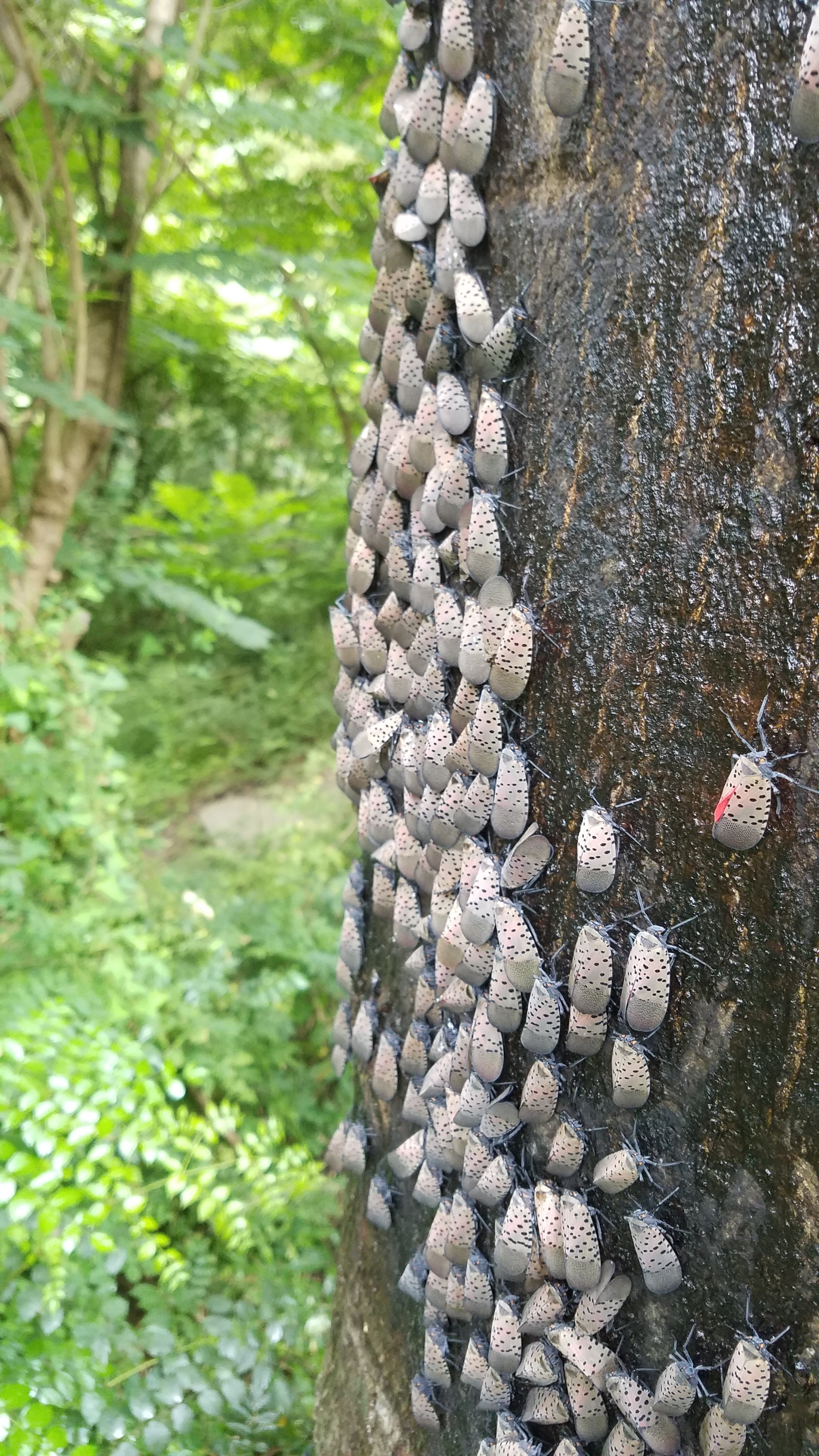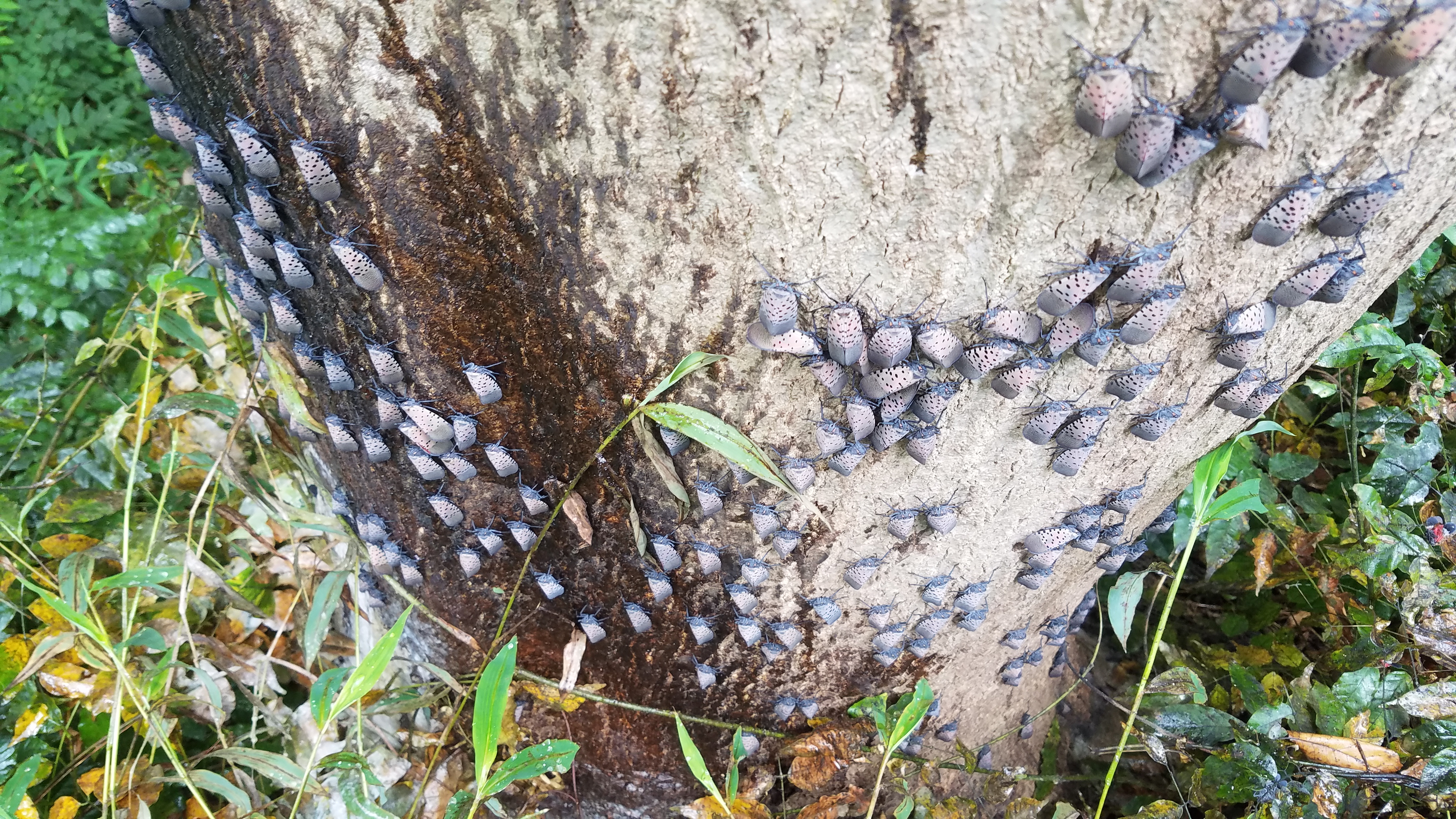By Executive Director Mike Weilbacher
A pair of concerned homeowners walked into the Schuylkill Center early last week in a bit of a panic. “We have lanternflies everywhere,” they told Steve Goin, our Director of Land and Facilities. “What do we do?” And many others have been calling our front desk with the same question.
What do we do indeed. Allow me to tell you.

The newest invasive creature in our backyards, spotted lanternflies were accidentally imported into Berks County from their native southeast Asia in 2014. And in the five years since, with no enemies, they have spread, decimating trees in a wide swath of southeastern Pennsylvania. Blessed with a hypodermic needle for a mouth, they suck the sap out of many different kinds of plants, including apple trees, grapevines, and hops, so farmers, brewers, and vintners, among others, are incredibly worried.
And it’s now that the adults have emerged from the cast-off skins of their baby selves, as insects do, the striking inch-long adults now sporting gray wings with black spots, and bright red underwings hiding beneath, easily seen when they fly—or typically hop—off.
So people are only noticing them now, and as they are still new to our yards, they are receiving a ton of attention. But what should you know about them?
First, they won’t harm you, as they don’t bite or sting.
Next, their host plant—the one they especially like to lay their eggs on, and upon which the flightless young stage pierces with its mouthparts to suck the sap from—is nicknamed “tree-of-heaven,” a fast-growing, widespread, and invasive tree introduced to the US from China in the 1700s; it is the title tree of “A Tree Grows in Brooklyn.” The Chesapeake Bay Foundation’s Caitlyn Johnstone wrote on that group’s website last year, “the plant’s presence creates a welcoming environment for the spread of the invasive bug.”
Here at the Schuylkill Center, we are seeing tree-of-heavens covered in lanternflies, thousands sucking out the sap, all the while excreting drops of “honeydew” from their rear ends, a very sweetened waste product (which can cover our cars, by the way). This honeydew then grows black sooty mold, the mold compromising the trees, which for us is actually doing something of a favor, killing the host plant.

“All of our tree-of-heavens are covered in them,” says Andrew Kirkpatrick, our Center’s Manager of Land Stewardship. “These trees are all going to die.”
But if you have a tree-of-heaven in your yard, this might not be a good thing. Some, like the state, recommend killing the critters as you find them. Andrew worried that might be a waste of your time. “If you take the time to kill the ones in your backyard,” he told me, “they’ll soon be replaced by more from your neighbors’ yards.”
Instead, he continued, “if you have a tree-of-heaven in your yard, and you’re concerned about the lanternfly, the best thing to do is to have it removed, because the tree is going to become a hazard. And if you see a lanternfly sucking on a desirable species like oak, maple, or beech,” as the adults to do after they leave their tree-of-heaven home, “then it may be worth having the tree injected with a pesticide that will kill the lanternfly when it tries to feed.”
If you, like me, shy away from pesticides, some suggest attaching sticky bands to the tree bark, the glue grabbing the insects as they walk up the tree to become adults. But Rebecca Michelin, the Director of Wildlife Rehabilitation for our Wildlife Clinic, cautions you here. “We have gotten seven birds [coming to the clinic] from glue traps, the most recent a downy woodpecker. None of the birds survived more than 24 hours. Along with injuries like skin tears and fractures, the enormous stress the birds are subjected to when they are trapped often overwhelms them, despite being provided with supportive care when they are admitted.
“The important thing,” she noted, “is to reduce the chance of bycatch as much as possible by decreasing the surface area of the bands and using mesh or fencing to keep larger animals out. Penn State has a good guide on their website for doing this—but there’s always the risk you will catch something you didn’t intend.” In fact, the extension website shows a photo of the sticky band having caught a ring of young lanternflies, along with a host of other good insects stuck on the glue as well. Even if you avoid catching birds or reptiles, it’s not without risks to other animals.
Last week, the Schuylkill Center’s summer camp held a new contest, a prize for the camp group that caught the most lanternflies. The winners—the Fantastic Foxes, by the way—caught 76 of the hoppers. In all, our kids caught and killed 120 of them.
The potential economic impact of this insect is still being assessed as it spreads into New Jersey, Delaware, Maryland, and surrounding states. Stay tuned. But there is yet another new invasive creature in our yards. And yet another ecological worry—as it there weren’t enough already.
Mike Weilbacher directs the Schuylkill Center for Environmental Education in Upper Roxborough, tweets @SCEEMike, and can be reached at [email protected].
